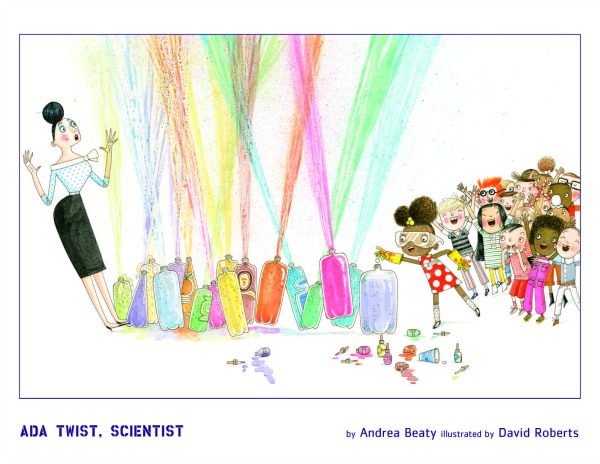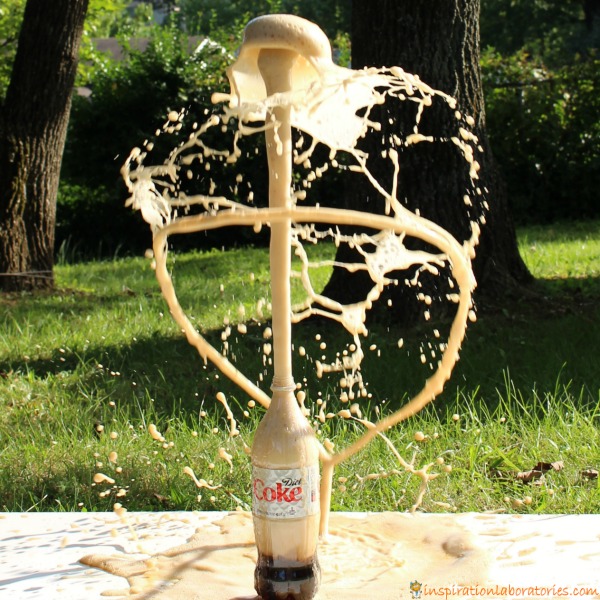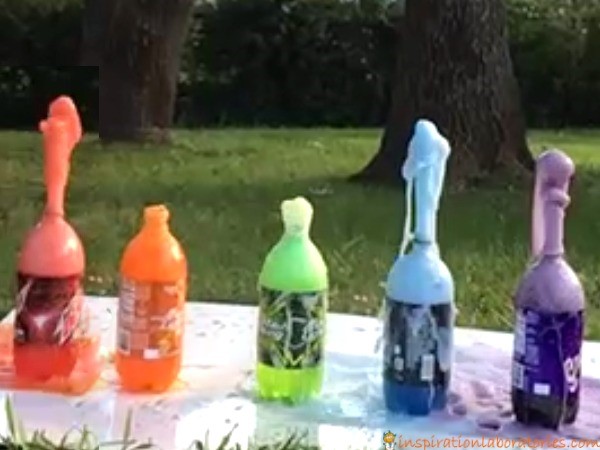Rainbow Soda Geysers with Ada Twist Scientist
We were sent a review copy of Ada Twist, Scientist – the latest book from the New York Times bestselling creators of Iggy Peck, Architect and Rosie Revere, Engineer. In the book, Ada loves asking questions and conducting experiments. We were inspired to try her rainbow soda geysers and discover more about how they work. This post contains affiliate links.

Ada Twist, Scientist by Andrea Beaty
Ada Twist, Scientist has a grand imagination and is hopelessly curious. She asks tons of questions and searches to understand the world around her. There is a terrible smell in her house. Like any good scientist, she sets out to discover what’s causing the smell by brainstorming ideas (by writing on the wall) and by conducting experiments. In the book, we also see Ada conducting other science experiments and sometimes getting into trouble. In one scene, Ada is at school with her classmates. She has set up a ton of soda bottles and they are spraying soda everywhere. We wanted to try to make rainbow soda geysers, too.

Diet Coke and Mentos Soda Geyer Experiment
The Diet Coke and Mentos soda geyser experiment has become a classic with Steve Spangler making it super popular. He even has geyser tubes specifically designed to help release the Mentos candy into the soda.
The Science Behind It
Soda contains dissolved carbon dioxide gas. It doesn’t take much to cause the carbon dioxide to form bubbles and try to escape the container. Just open the container to release the pressure and watch some of the gas escape. Dropping something into the soda will cause the carbon dioxide bubbles to form around the object and the bubbles can then rise as well. Mentos candy has a lot of surface area – it has tiny pits all over the surface of the candy. This allows lots of places for the carbon dioxide bubbles to form. Lots of gas forming at once is what causes the geyser. It’s all trying to escape the bottle at the same time.

The Experiment
What You’ll Need:
- Soda
- Mentos
- Tape (to hold your Mentos or create your own launch tube)
To design your experiment, you’ll need to decide on what you want to test. Here is a list of ideas:
- Type of soda – Diet Coke is thought to work the best. Test this idea by choosing different types of soda. Try regular cola vs. diet, different brands of diet cola, cola vs. orange vs. lemon-lime, etc.
- Amount of Mentos – Does changing the number of Mentos dropped in at a time affect the height of the geyser?
- Temperature of the soda – Does warm soda produce a higher geyser than cold soda?
- Size of the bottle – Will a 2 liter bottle make a higher geyser than a 1 liter bottle?
- Type of candy – Are there candies besides Mentos that will make a soda geyser? Do different flavors of Mentos impact the soda geyser?
Aiden wanted to test the size of the soda container, so we compared 2 liter bottles of Diet Coke to 1 liter bottles of Diet Coke. We placed a piece of tape down the side of 5 Mentos in order to drop them into the container at the same time. You could also roll up a piece of paper and create a launch tube from that.

Our 2 liter bottles definitely created higher geysers than the 1 liter bottles, but the 1 liter bottles create some pretty cool geysers. Watch the video in slow motion below.
Rainbow Soda Geysers
Then, we set up a rainbow of sodas. We dropped 5 Mentos in each of the sodas at relatively the same time.

We noticed that certain sodas formed a geyser much more quickly than other geysers. A couple of the sodas weren’t impressive at all. None of the colorful sodas reached the height of the Diet Coke.
Watch the slow motion video below:
More Science Ideas
For more Ada Twist, Scientist resources, head over to the publishers page. You’ll find a teaching guide, activity sheets, and more science experiments from the blog tour.
Subscribe to the Inspiration Laboratories newsletter. Each issue has exclusive hands-on science explorations for children, a recap of our latest activities, and special resources selected just for you!
![]()


Leave a Reply